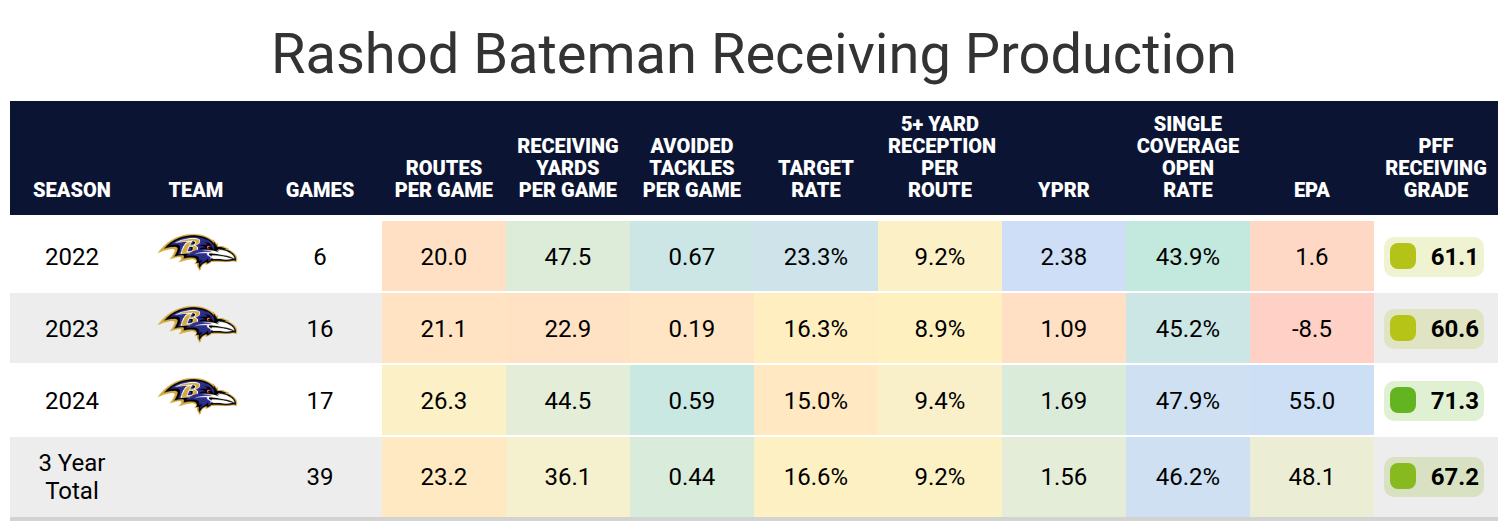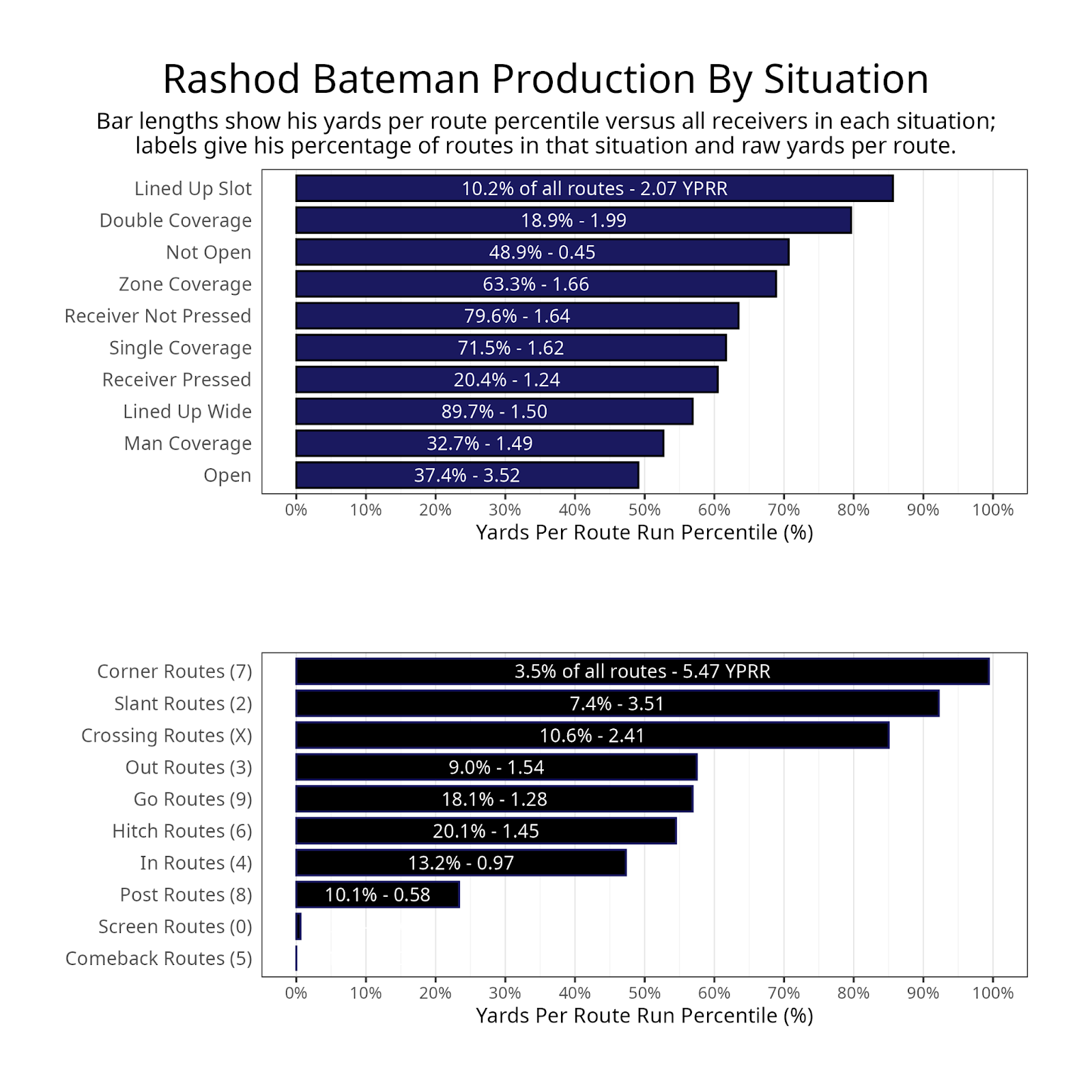
- Rashod Bateman‘s flash potential: Bateman, with the Baltimore Ravens, has shown big-play ability, particularly as a deep threat but has yet to become a reliable fantasy starter consistently.
- New target competition in 2025: With the DeAndre Hopkins addition, Bateman’s target share could decrease, making him a risky fantasy option for the upcoming season despite his ability to make big plays.
- Subscribe to PFF+: Get access to player grades, PFF Premium Stats, fantasy football rankings, all of the PFF fantasy draft research tools and more!
Estimated Reading Time: 5 minutes

PFF’s Fantasy Football Player Profile series delivers the most in-depth fantasy football analysis available for the 2025 season.
Using PFF’s exclusive data, we evaluate player performance, competition for touches and how teammates and coaching staffs
Last updated: 7:15 a.m. Wednesday, June 18
Player performance
Rashod Bateman was a first-round pick by the Baltimore Ravens in 2021. The Ravens were using 2019 third-round pick Miles Boykin as their X receiver, but Bateman was expected to be an upgrade. However, Bateman missed the first five games due to a groin injury that lingered on later in the season. Bateman had three games over 80 receiving yards, but only scored one touchdown, and his impact was limited in the rest of his games.
Bateman was off to a fine start in his second season, finishing with eight receptions for 226 yards and two touchdowns over the first three weeks. He was WR30 at this point of the season, but a foot injury in Week 4 cost him Weeks 5 and 6. He tried to play again in Weeks 7 and 8 but then opted for surgery on his foot to end his season.
Bateman was finally able to play nearly a full season in 2023, missing just one game. However, he only played 57.1% of Baltimore’s offensive snaps throughout the season and was generally a high average depth of target deep threat. He was held to one touchdown again and only had one game above 40 receiving yards. His season high in receptions and yards both occurred in Week 17 with four receptions for 54 yards. The problem was that he spent the entire season rotating with Odell Beckham Jr., who was the Ravens’ best wide receiver on a per-play basis. Generally, when two wide receivers are rotating for the same spot, it’s nearly impossible to trust either for fantasy purposes.
The Ravens moved on from Beckham, allowing Bateman to be the clear X receiver for the first time in his career. He also didn’t miss a game for the first time. Bateman’s target rate decreased, but yards per game increased as he made more big plays. Bateman caught eight of 15 deep passes for 292 yards and five touchdowns, and his touchdown total was tied for the second-most. He had a 36.7-yard average depth of target on his deep targets, the most for a wide receiver with 15 or more deep targets.
Bateman gained at least 10 yards on 68.9% of his receptions and at least 15 yards on 51.1% of his receptions, which were both second-most among wide receivers. Bateman had a high rate of being a top-12 fantasy wide receiver last season but has been outside the top 48 wide receivers in over half of his games in each season of his career. This has made it impossible to ever start him in redraft leagues but makes him a more intriguing prospect in best ball or DFS.
Bateman has high single coverage open rates and a decent yards per route run, suggesting he could be a better receiver than his traditional statistics suggest.


Projected role
Bateman’s role in the offense is the big reason Bateman’s fantasy value has been held back. He’s just a deep threat because the Ravens have Zay Flowers as the Z receiver in addition to Mark Andrews and Isaiah Likely at tight end to dominate the shorter targets. Baltimore doesn’t need Bateman to have a high target rate to succeed, and it helps the rest of the offense to have Bateman run his deep targets.
His situation is even more complicated this season. Last year, Nelson Agholor was the Ravens’ third wide receiver. He played primarily in the slot. The Ravens drafted Devontez Walker to be Bateman’s backup, but he barely played on offense. This season, future Hall of Fame prospect DeAndre Hopkins was added to the team. He’s historically been an X receiver. He’s only played a part-time role in recent seasons, so he probably won’t fully overtake Bateman in the offense. There is a solid chance that Hopkins will be able to take some time away from Bateman in two-receiver sets, particularly on passing plays, which will make it even harder to trust Bateman for fantasy purposes.
In three-receiver sets, we could see Bateman, Hopkins and Flowers together on the field at the same time. This could allow Bateman to be more than just a deep threat on these plays, but that probably won’t be enough to make up for lost time in two-receiver sets. The Ravens play fewer three-wide receiver sets than any other team because they have both Anders and Likely. There is also a chance Walker improves in his second season and earns a little more playing time.


Impact of teammates
Bateman will be in Todd Monken’s offense for a third-straight season. Monken helped make the Ravens more pass-heavy in the past, but the Derrick Henry addition last season put another ceiling on Bateman. Even if Bateman played 100% of Baltimore’s offensive snaps, the Ravens are winning so many games, and it makes sense for them to run the ball, so Bateman’s routes will be more limited than most other wide receivers.
Bateman will continue catching passes from Lamar Jackson as he’s done his entire career. On the bright side, that has meant a high deep target rate with decent deep target accuracy. That has also meant Bateman has been a part of one of the best offenses in the NFL, giving him more opportunities to score points. However, that also comes with Jackson scrambling or getting sacked on a high percentage of plays. Jackson’s abilities in the run game make it much easier for everyone in their run game, which encourages the offense to run more often.


Bottom line
Rashod Bateman has never been a fantasy starter in redraft leagues, and the DeAndre Hopkins addition will make it even more difficult for Bateman to reach that mark. There is always a chance that Bateman just improves enough as a player to warrant a bigger role in the offense. Without that, Bateman will be a very high-risk, high-reward option who will be better in best ball and DFS than redraft.

Footnotes
- Statistics in tables and charts were chosen based on their ability to predict future fantasy performance on a per-game or per-opportunity basis or to describe the player relative to others at the same position.
- “Opportunities” are defined as passing dropbacks, rushing attempts and routes run as a receiver.
- Numbers are provided either by season or based on the past three years. For rookies, only college statistics are included. For non-rookies, only NFL statistics are considered, regardless of whether they played in college within the previous three years.
- As college competition is easier than NFL competition, most rookies are likely to see a decline from their historical numbers.
- Only FBS data is considered for college players and comparisons.
- Kneel-downs are removed from rushing data to provide cleaner quarterback rushing rate statistics.
- The table colors in this article range from blue (indicating good/high) to red (indicating bad/low).
- All percentiles and color codings compare the given player to others with a high sample of opportunities. Generally, the cutoff is one-third of the possible opportunities in the sample. If a player does not meet the threshold, they are still included in the comparison, though their results may appear better or worse than expected due to the smaller, less predictive sample size.
- Information on utilization classifications and their importance can be found here for running backs, wide receivers and tight ends.
This news was originally published on this post .






Be the first to leave a comment